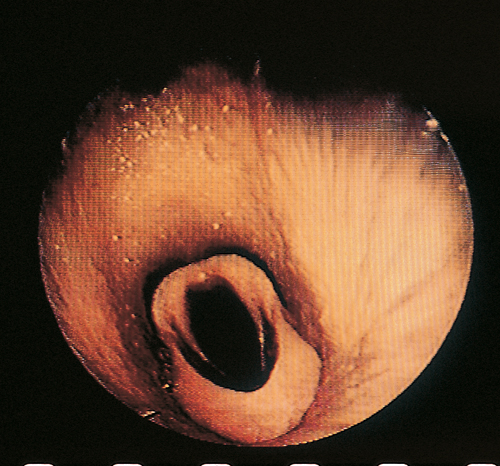Difference between revisions of "Equine Internal Medicine Q&A 07"
Ggaitskell (talk | contribs) |
|||
| Line 19: | Line 19: | ||
Alternatively, the aryteno-epiglottic fold can be approached through the mouth or nose, after which the fold is divided in the midline using either a hook with a cutting edge on the inside of the hook, or transendoscopically using Nd:YAG laser, or transendoscopically using monopolar electrosurgical cutting equipment. <br><br> | Alternatively, the aryteno-epiglottic fold can be approached through the mouth or nose, after which the fold is divided in the midline using either a hook with a cutting edge on the inside of the hook, or transendoscopically using Nd:YAG laser, or transendoscopically using monopolar electrosurgical cutting equipment. <br><br> | ||
Transendoscopical treatment can be performed in the standing animal. | Transendoscopical treatment can be performed in the standing animal. | ||
| − | |l2= | + | |l2=Epiglottic Entrapment#Treatment |
|q3=What postoperative complications may occur? | |q3=What postoperative complications may occur? | ||
|a3= | |a3= | ||
Latest revision as of 14:13, 22 August 2011
| This question was provided by Manson Publishing as part of the OVAL Project. See more Equine Internal Medicine questions |
You are asked to examine a three-year-old Thoroughbred mare with a history of intermittent coughing and exercise intolerance. The cough is said to be most pronounced when the horse is eating. The animal is clinically healthy but during light exercise you hear an abnormal noise during both inspiration and expiration. Endoscopic examination reveals the lesion shown in the image.
| Question | Answer | Article | |
| What is your diagnosis? | Epiglottic entrapment. |
Link to Article | |
| Describe two basic methods for surgical correction. | The entrapped epiglottis can be approached through a ventral midline laryngotomy, after which the aryteno-epiglottic tissue is resected. Alternatively, the aryteno-epiglottic fold can be approached through the mouth or nose, after which the fold is divided in the midline using either a hook with a cutting edge on the inside of the hook, or transendoscopically using Nd:YAG laser, or transendoscopically using monopolar electrosurgical cutting equipment. |
Link to Article | |
| What postoperative complications may occur? | Dorsal displacement of the soft palate may occur, especially after resection of the aryteno-epiglottic fold. This is most likely to occur if dorsal displacement of the soft palate was observed prior to surgery, or if the epiglottis is hypoplastic or deformed. |
Link to Article | |
